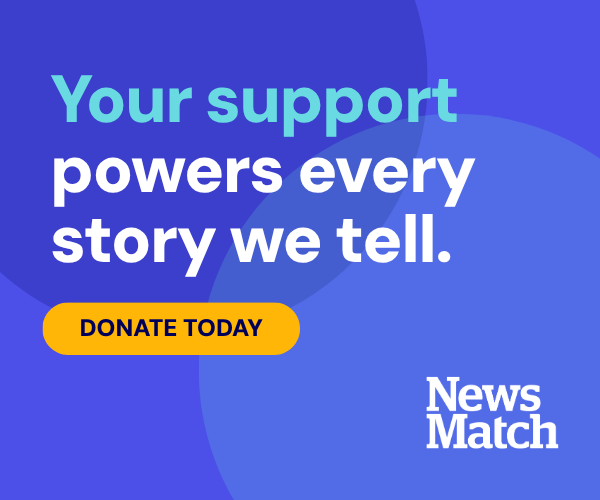Arts & Entertainment Community Education Health & Wellness
Jennifer Preston | A place to play
The purpose of play
“We don’t stop playing because we grow old; we grow old because we stop playing.”
– George Bernard Shaw
Forward-thinking municipalities know good things happen when citizens have a place to gather and grow. A thriving, local community provides both space and events for people of all ages and abilities to interact. You can judge a city’s attitude towards its citizens by looking at what it has to offer.
Most of us are familiar with the physical benefits of play, but the social and emotional aspects are equally important. Unstructured free play for children encourages collaboration and increases empathy. It helps kids learn conflict resolution and safely explore emotions.
Play stimulates brain development, according to The Hechinger Report, a nonprofit, independent organization focused on inequality and innovation in education. It also boosts creativity, problem-solving and critical thinking skills.
And it’s fun!

Unstructured free play for children encourages collaboration and increases empathy. It helps kids learn conflict resolution and safely explore emotions.
How to play
An integral component missing from many activities today is called ‘free play.’ This is unstructured play that occurs without adult direction. It’s the difference between an organized sport, like flag football with coaches and parents on the sidelines, and a group of kids let loose on a playground inventing games as they go.
Dr. Peter Gray is a psychologist, researcher and author of Free to Learn: Why Unleashing the Instinct to Play Will Make Our Children Happier, More Self-Reliant, and Better Students for Life (Basic Books, 2013). Gray discusses why free play is essential for developing healthy, well-adapted children and suggests ways to bring this important but overlooked component back.
In his Ted Talk The Decline of Play, Gray discusses a connection between a decline in the amount of time kids spend playing together in unstructured settings and an increase in depression, anxiety and narcissism.
When to stop playing?
NEVER.
While we know that play is important to children’s development, research proves it’s important for adults’ overall well-being, too.
PsychCentral points out that it stimulates creativity, boosts a sense of humor and builds resilience to stress throughout our lives.
The spontaneous, expressive, fun and silly behavior that play offers, helps us appreciate beauty, bestows a sense of hope and infuses life with excitement and energy. Yet, many of us don’t play enough anymore.
Adults in ‘time-out’
Obviously, adults have more responsibilities than kids. We’re busy with jobs, errands, appointments — the list is endless. On top of that, adults don’t have playtime baked into their schedules like school recess, birthday parties and play dates. It’s also harder for adults to ‘let go’ and ‘let loose’ because of self-awareness and anxiety over being judged.
Adults must be intentional when seeking out play — which ironically means less spontaneity. But don’t let that dampen your mood! Once lack of inertia is overcome, setting aside time for playful activities can lead to a habit that is easier to maintain.
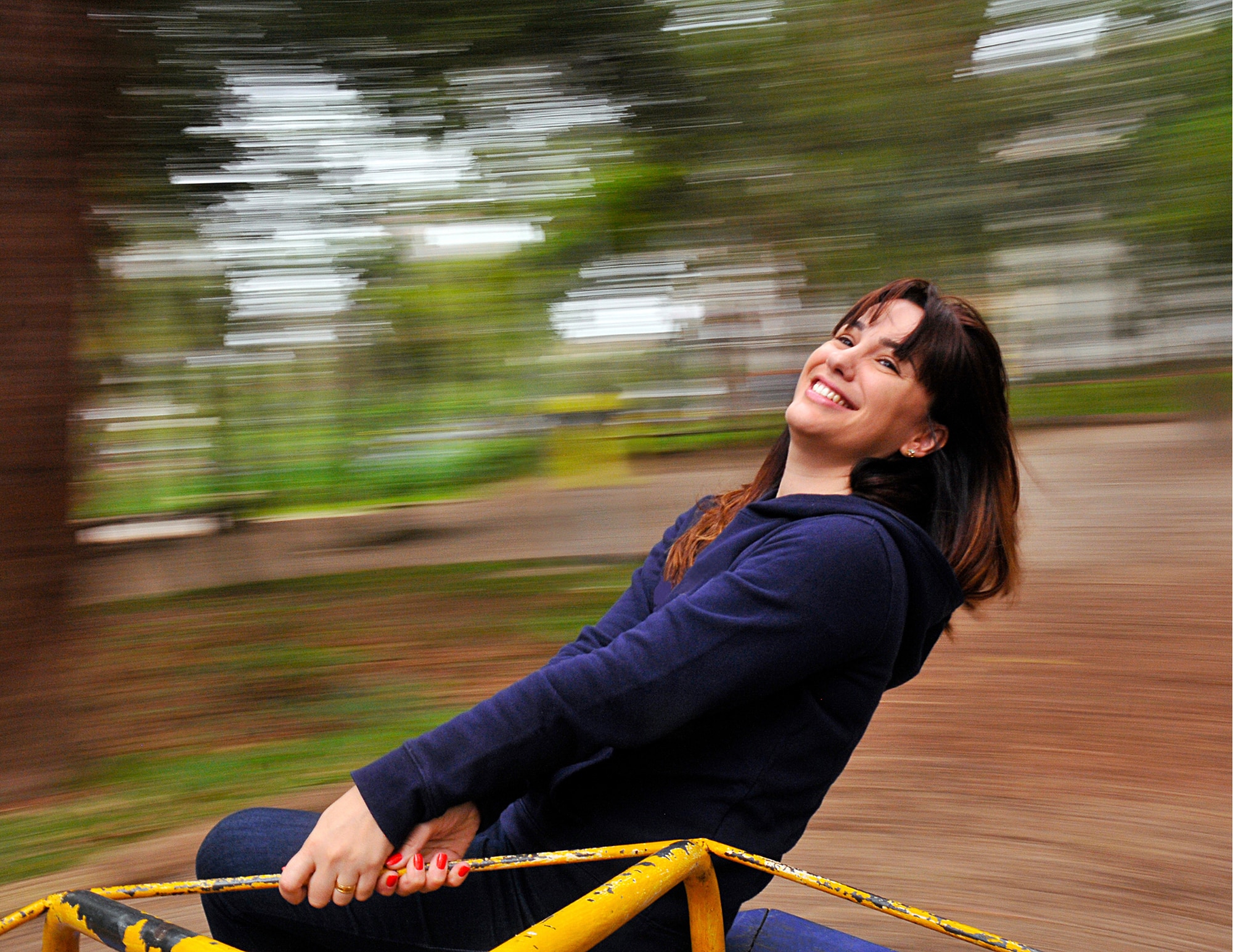
Adult play can take on many different forms.
What is your play personality?
Play can take many forms. It’s all about personal preference.
Most things that bring you joy or excitement count, anything from playing sports, video games, cards and board games, to hiking and foraging, cooking and writing, to making crafts, dancing and plain old goofing around (remember pranking friends?).
Take a moment to consider what makes you happy. What activities are so engrossing that you lose a sense of time and feel refreshed and energized rather than drained when you’re done? This is often referred to as a ‘flow state.’
Read the list below to help you decide what Dr. Stuart Brown, founder of The National Institute for Play, calls the eight “play personalities.”
- The Collector: You enjoy building collections, such as collecting seashells, stamps or vintage cars.
- The Competitor: You enjoy playing (and winning) games with specific rules, like playing for a neighborhood softball league.
- The Creator or Artist: You find joy in making things or fixing them. You might enjoy doodling, woodworking, decorating, repairing machinery or sewing.
- The Director: You enjoy planning and directing, like hosting themed events and birthday parties.
- The Explorer: You play by discovering something new, either physically, like traveling to an unfamiliar place, or mentally, like attending a pub lecture.
- The Joker: You like acting silly and possibly pranking friends and family. You might enjoy improv theatre or just making your friends laugh.
- The Kinesthete: You enjoy moving your body as play. You might practice yoga or take dance classes for fun.
- The Storyteller: You play by listening to or creating stories. You might enjoy going to the theater or writing a journal.
Brown only proposed eight play personalities, but I propose nine, which is a combination of several options, or even all of them!
Not a one-size-fits-all scenario
An activity considered playful by one person can be absolute drudgery for another, says Gray.
“Two people might be throwing a ball . . . or typing words on a computer, and one might be playing while the other is not. To tell which one is playing and which one is not, you have to infer from their expressions and the details of their actions.”
PhDs in play
Did you know that some colleges offer degrees in play? Called Recreation and Leisure Studies, graduates are often employed by cities to help organize recreational options.
Locally, Western Washington University offers a Recreation and Management B.A. Their website states:
“The purpose of recreation and leisure is to contribute to the health and well-being of individuals and enhance the quality of community life. As such, the study of recreation is multidisciplinary, requiring understanding of the social, behavioral, physical, and environmental sciences as they pertain to helping people grow and develop in their leisure while conserving our vital natural resources. Knowledge of the arts and humanities is important as well, because leisure is one of the most fertile opportunities for self-expression and the development of community.”
Graduates often find work in parks departments, social organizations, nursing homes and similar environments.
According to the U.S. Bureau of Labor and Statistics, this position is projected to grow 5% from 2022 to 2032, faster than the average for all other occupations. The median annual wage for people employed in the Recreation and Leisure field is $31,680, or $15.23 hourly (May 2022).
The BLS website states:
“An increased emphasis on the importance of lifelong well-being is expected to create demand for recreation workers in a variety of settings, including fitness and recreational sports centers, country clubs, and other organizations. Parks and recreation departments may contract out the services of activity specialists.”
Given increases in wellness focus, hopefully recreation workers will be more valued and compensated.
Third Place
The “Third Place” environment refers to social surroundings separate from home (‘First’ place) and work (‘Second’ place).
The phrase was created by sociologist Ray Oldenburg, professor emeritus at the University of West Florida in Pensacola and the author of “The Great Good Place.” Oldenburg says it’s “where people relax in good company and do so on a regular basis.”
Oldenburg argues for the necessity of informal public and civic life, explaining that these spaces are essential to both community health and individual well-being. Examples include churches, cafes, bars, clubs, community centers, performing arts centers, public libraries and parks.

A good Third Place can create opportunities for people of all ages to interact.
Third Places can break down social silos, which are invisible barriers between groups of people, like youth and elderly. For example, innovative architects are building “common spaces” into senior housing developments with café-style ambiance that link nearby universities and other active spots, which attracts a wider variety of the populace and encourages co-mingling.
The Brookings Institute, a Washington, D.C.-based nonpartisan organization working to improve policy and governance, explains these interactive opportunities are “in stark contrast to the common pattern of creating self-segregated elderly enclaves, with elaborate services but little contact with the outside community.”
Creating people places
“The creation of something new is not accomplished by the intellect but by the play instinct.”
– Carl Jung
Gathering spots like Third Places strengthen community bonds several ways. Planned properly, they revitalize neighborhoods, stimulate business and boost property values. And these are only the economic benefits.
Just as important and often overlooked are the many mental and physical advantages to social gatherings, which are less quantifiable, such as stress reduction, chronic disease prevention and promoting general well-being.
Since we now know that playgrounds, community centers and recreational activities foster a sense of belonging in the community, how do we identify and create play-focused programing cities can adopt?
A personal perspective
Many of you recall that Gig Harbor was a sleepy bedroom community mostly made up of people wanting an affordable, quiet place to retire and folks that appreciated the rural lifestyle. I remember the many dusty pickups driven by farmers in cowboy hats, their beds stacked with hay.
The area was not geared for young families and kids. But that changed gradually, at first.
In 2000, my mom, Susan Beck, arrived here with four of my younger siblings and my grandmother in tow. She was a single mom and an economic refugee from Irvine, Calif.
The family was thrilled at the natural beauty of Washington state, and of Gig Harbor in particular. However, she was surprised by the lack of playgrounds and that many “parks” were undeveloped green areas merely set apart with a sign.
My mom saw a need for creating a robust parks program. After a lot of research, working alongside like-minded citizens, and even a bit of play, she helped form the Peninsula Metropolitan Park District (PenMet Parks). These early advocates gathered enough support to place it on the ballot and the voters of unincorporated Gig Harbor successfully passed Proposition No. 1 during the May 2004 special election.
On the very same ballot, community members ran to serve on the Parks’ first Board of Commissioners with the unique caveat that voters approved forming PenMet Parks, of course!
‘Maintaining a balance’
Her personal statement for the Voter Pamphlet still resonates and remains something I value in my own hope and vision for the future of our parks. In 2004 she wrote: “Dedicated to promote and protect our unique peninsula environment, while maintaining a balance between the needs of the community, and the needs of our vulnerable ecosystems . . .”
According to the PenMet Parks’ website, the burgeoning district managed 12 acres of property in 2004. Today, they manage 652 acres of park land.
Gig Harbor City Parks and PenMet Parks . . . confusing
“A little nonsense now and then is cherished by the wisest men.”
– Roald Dahl
Gig Harbor’s explosive population growth led to schools and recreation facilities being built as quickly as possible by both the city of Gig Harbor’s Parks Department and PenMet Parks in unincorporated areas. This has led to some confusion in our community about where parks, services and funding originates.
To better understand the distinction between Gig Harbor’s Parks Department and PenMet, you need to look at a map and understand the tax system in place that supports current programs.
PenMet Parks is responsible for parks outside Gig Harbor city limits. Cushman Trail is a special case because it is Gig Harbor’s responsibility within the city, but PenMet’s outside city limits. Both share responsibilities with Tacoma Public Utilities.
While many area residents enjoy Gateway/360 Park, Banner Forest Park and more, those park properties are operated by two other jurisdictions. The former by Key Peninsula Parks, and the latter by Kitsap County Parks. PenMet’s boundary stays within Pierce County in unincorporated Gig Harbor.
Many have called for both Gig Harbor Parks and PenMet to be combined to clarify and streamline decisions. Unfortunately, it’s not that easy because the two are supported by different property tax bases, individual grants and either contract with non-profit organizations to run their recreational programs or hire employees to provide them internally.
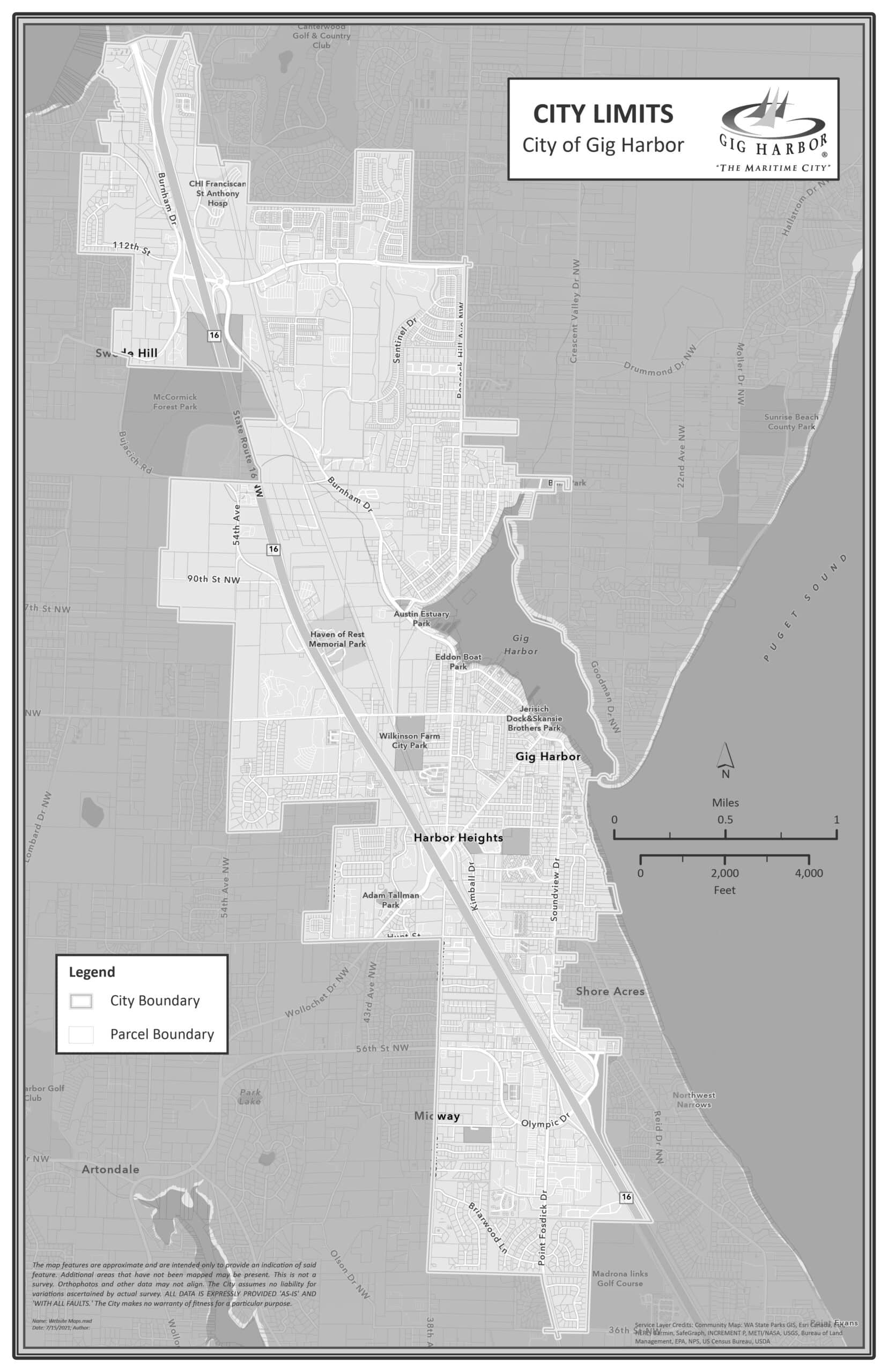
The city limits of Gig Harbor. PenMet Parks operates outside these limits.
PenMet’s recent decision to charge “non-residents” (people outside its boundaries) 20% extra for recreational services — and to bar registration for programs until a week after “residents” have an opportunity to enroll — deserves a more in-depth look in a future article.
This interactive map that will clarify if your home is within the city of Gig Harbor or unincorporated Pierce County (PenMet).
A place to play
I had hoped to provide links to maps of Gig Harbor and PenMet parks, but the City link is broken and PenMet’s list is confusing because they list 13 parks on their Google Map and 21 parks on their District Map.
To remedy this, I created a Google Map that shows both Districts’ properties. City parks not listed on their website, but added by me, include Soundview Park and the under-construction Gig Harbor Sports Complex.
How cities support play
“The opposite of play is not work, it’s depression.”
– Brian Sutton-Smith
Faced with multiple challenges every day, cities best adept at meeting challenges have three characteristics: they’re flexible, interconnected and anticipate change.
“Cities are systems — not silos,” points out the Resilient Cities Network. However, the current approach is just that. “Urban governance is often siloed, with separate teams designing disaster recovery plans, exploring sustainability issues, focusing on livelihoods and well-being, and examining land-use planning and infrastructure. This approach cannot meet the demands of today’s interconnected world.”
A holistic approach to problem-solving is paramount. This creates urban resilience, which is “the capacity of individuals, communities, institutions, businesses and systems within a city to survive, adapt and grow no matter what kinds of chronic stresses and acute shocks they experience.”
The way to whimsy
“Children don’t need more things. The best toys a child can have is a parent who gets down on the floor and plays with them.”
– Anonymous
Designing and planning spaces for recreation based on economics, like attracting shoppers to a local business district, leads to disjoined visions. It feels fake and people see through it.
Beyond that, it’s a disservice to the neighborhood it serves if the community’s needs aren’t prioritized.
However, if we stop to consider the deeper reasons for building these structures, and the proper path to get there, all visions can be realized. This includes creating goals that come from an understanding about what the community wants.
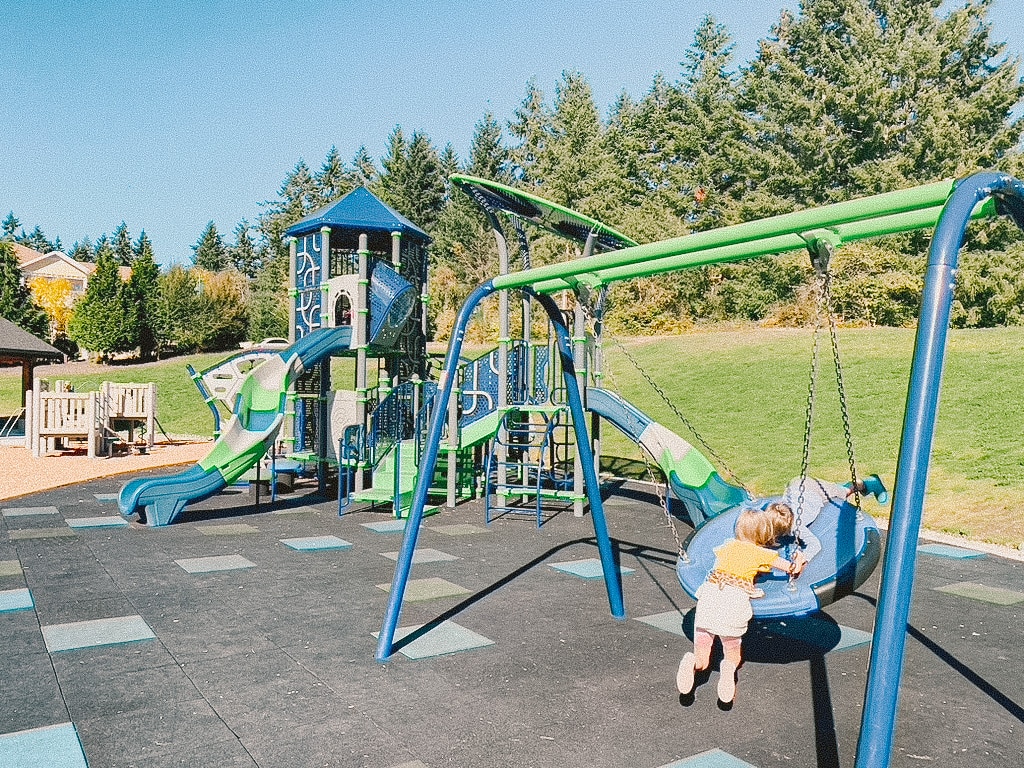
Playground at Kenneth Leo Marvin Veterans Memorial Park, 3580 50th Street Court
How do you know? You ask them.
This can be as simple as an informal poll on the website Nextdoor, which is a hyperlocal social networking service for neighborhoods.
A community that plays together stays together
“It is a happy talent to know how to play.”
– Ralph Waldo Emerson
Playgrounds and expanding services lead to more recreational opportunities for all citizens, regardless of age and abilities. Designing space for people with diverse needs and interests seems so obvious, it’s surprising when cities overlook these two basic tenants.
Many parks departments focus on building fields for baseball, softball, soccer, basketball, pickleball and more, which emphasize competitive, physical play. This approach assumes the majority of citizens both want to play these games and can physically participate.
Healthy, innovative cities can promote more accessible play several ways. They begin by offering safe and inviting space for it.
There are many opportunities to connect the community with universal and inclusive approaches to indoor play. For example, low-impact dance lessons, raised bed greenhouse gardening and “pub lecture” learning programs offered in warm, inviting spaces.
We need welcoming places for all ages to gather where we can learn and grow together. This is what makes cities thrive!
A center for the whole community
A dedicated community center is a wonderful place for these types of programs, but Gig Harbor currently lacks this amenity. Planners may point to the Community Recreation Center (CRC) facility being built, but look closely at the specs and you’ll see we are woefully underserved.
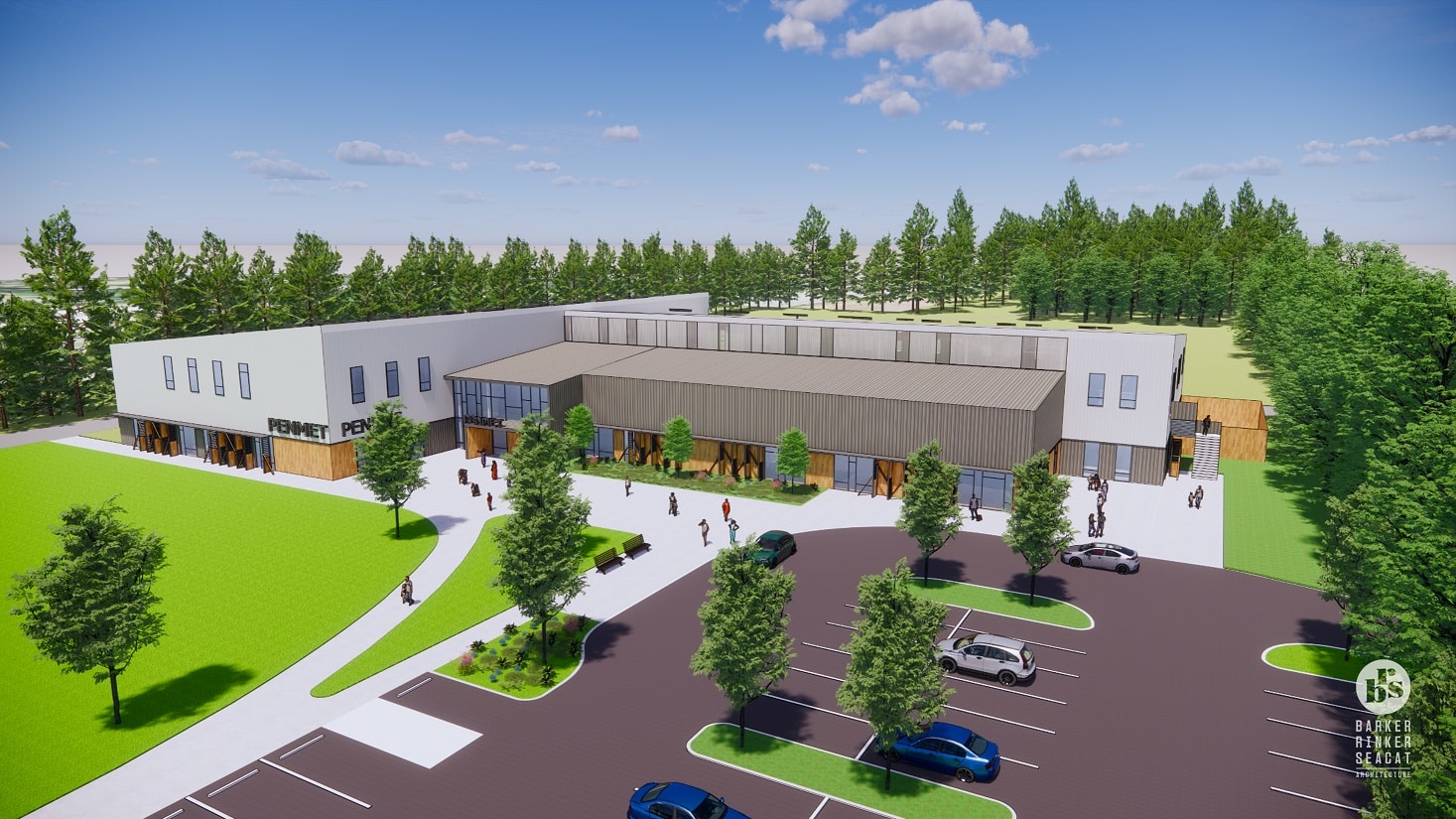
A sketch of Phase 2 of the Community Recreation Center.
With a 17.23 acre campus and a 58,000-square-foot indoor facility, why is the area set aside for community gathering so incredibly small, especially given our many months of inclement weather?
The PenMet Parks website describes the CRC building under construction:
“The Community Recreation Center (CRC) will be a destination. We envision families and friends riding their bikes on the Cushman Trail and meeting at the CRC for a soccer game, an enrichment program, or a community event. The CRC will be the one space that brings recreational programming and gathering opportunities within everyone’s reach.
With an indoor jogging track, sports courts, indoor turf field, and multiple gathering spaces, the CRC will be more than a recreation facility. It will be a community hub bringing together families, friends, and neighbors of all ages to play, connect, and grow.”
Will this truly be a “place for everyone?”
In the next article I’ll discuss how cities engage their communities through public art and why inviting local artists to participate benefits everyone.

Jennifer Preston
Jennifer Preston of Gig Harbor is an award-winning writer, designer, eco-advocate and certified Master Gardener.

